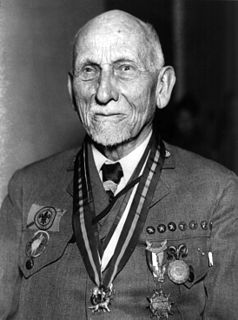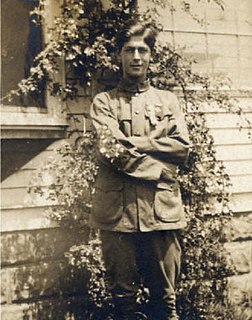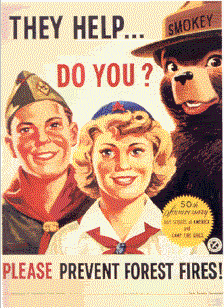Related Research Articles

The Boy Scouts of America is one of the largest scouting organizations and one of the largest youth organizations in the United States, with about 1.2 million youth participants. The BSA was founded in 1910, and since then, about 110 million Americans have participated in BSA programs. BSA is part of the international Scout Movement and became a founding member organization of the World Organization of the Scout Movement in 1922.

A Scout is a child, usually 10–18 years of age, participating in the worldwide Scouting movement. Because of the large age and development span, many Scouting associations have split this age group into a junior and a senior section. Scouts are organized into troops averaging 20–30 Scouts under the guidance of one or more Scout Leaders or Scoutmasters. Troops subdivide into patrols of about 6–8 Scouts and engage in outdoor and special interest activities. Troops may affiliate with local, national, and international organizations. Some national Scouting associations have special interest programs such as Air Scouts, Sea Scouts, outdoor high adventure, Scouting bands, and rider Scouts.

Scouting in Missouri has a long history, from the 1910s to the present day.

Eagle Scout is the highest achievement or rank attainable in the Scouts BSA program of the Boy Scouts of America (BSA). Since its inception in 1911, only four percent of Scouts have earned this rank after a lengthy review process. The Eagle Scout rank has been earned by over 2.5 million youth.
Advancement and recognition in the Boy Scouts of America is a tradition dating from the inception of the Scouting movement. A fundamental purpose of advancement is the self-confidence a young man or woman acquires from his participation in Scouting. Advancement is one of the methods used in the "Aims of Scouting"– character development, citizenship training and personal fitness.

Pioneering is the art of using ropes and wooden spars joined by lashings and knots to create a structure. Pioneering can be used for constructing small items such as camp gadgets up to larger structures such as bridges and towers. These may be recreational, decorative, or functional.

Merit badges are awards earned by members of the Boy Scouts of America, based on activities within the area of study by completing a list of periodically updated requirements. The purpose of the merit badge program is to allow Scouts to examine subjects to determine if they would like to further pursue them as a career or vocation. Originally, the program also introduced Scouts to the life skills of contacting an adult they had not met before, arranging a meeting and then demonstrating their skills, similar to a job or college interview. Increasingly, though, merit badges are earned in a class setting at troop meetings and summer camps.

Daniel Carter "Uncle Dan" Beard was an American illustrator, author, youth leader, Georgist and social reformer who founded the Sons of Daniel Boone in 1905, which Beard later merged with the Boy Scouts of America (BSA).

Varsity Scouting was a program of the BSA. It was an alternative available to boys ages fourteen to eighteen until the end of 2017. It used the basic Boy Scouting program and added high adventure, sporting, and other elements that were more appealing to older youth to accomplish the aims of character development, citizenship training, and personal fitness. Varsity Scouts were organized into teams; separate chartered units from a Boy Scout troop.

Eagle Scout is the highest rank awarded to a Senior Scout in the Boy Scouts of the Philippines (BSP). To be awarded the rank, a Scout must lead in planning and doing two community service projects and earn a total of 23 merit badges consisting of 17 required merit badges and 2 specialist ratings. After achieving the rank of Eagle, a Scout may earn an Anahaw award for earning 2 additional specialist ratings.
The history of merit badges in the Boy Scouts of America (BSA) has been tracked by categorizing them into a series of merit badge types. In addition to the Boy Scouts of America, many other Scouting and Scouting-like organizations around the world, such as Pathfinders, Baden-Powell Scouts and Royal Rangers, issue merit badges or their equivalent; though they are sometimes called honors or proficiency badges. Other organizations, such as fire brigades, issue badges or awards that they refer to as merit badges, but that are in some respects different from the badges awarded by the BSA.

Arthur Rose Eldred was an American agricultural and railroad industry executive, civic leader, and the first Eagle Scout in the Boy Scouts of America (BSA). As a 16-year-old candidate for the highest rank bestowed by the BSA, he was personally interviewed by a panel composed of the youth organization's founders, including Ernest Thompson Seton and Daniel Carter Beard. Eldred was awarded the coveted distinction of Eagle Scout on September 2, 1912, becoming the first of more than two million boys in the U.S. since then to earn Scouting's most vaunted rank. Eldred also received the Bronze Honor Medal for lifesaving, and was the first of four generations of Eagle Scouts in his family.

Scouts BSA is the flagship membership level of the Boy Scouts of America (BSA) for boys and girls between the ages of typically 11 and 17. It provides youth training in character, citizenship, and mental and personal fitness. Scouts are expected to develop personal religious values, learn the principles of American heritage and government, and acquire skills to become successful adults.

Since Scouting began in 1907, it has entered into many elements of popular culture, including movies, TV and books.

First Class Scout is a rank in the Boy Scouts of America, the rank above Second Class and below Star Scout. It is the highest of the lower four ranks in Scouting, and is the minimum rank that need be attained for entry into the Order of the Arrow.

The Boy Scouts of America (BSA) was inspired by and modeled on The Boy Scouts Association, established by Robert Baden-Powell in Britain in 1910. In the early 1900s, several youth organizations were active, and many became part of the BSA.

The advancement program for Scouts participating in the Scouts BSA program of the Boy Scouts of America is symbolized by the earning of seven ranks. The advancement program is often considered to be divided into two phases. The first phase from joining to First Class is designed to teach the scout Scoutcraft skills, how to participate in a group and to learn self-reliance. The Scout badge is awarded when the Scout demonstrates a rudimentary knowledge of the Scouting ideals and program. Tenderfoot, Second Class, and First Class have progressively harder requirements in the areas of Scoutcraft, physical fitness, citizenship, personal growth and Scout Spirit.

The Eagle Scout Service Project, or simply Eagle Project, is the opportunity for a Scout, or qualified Venturer or Sea Scout in the Boy Scouts of America (B.S.A.) to demonstrate leadership of others while performing a project for the benefit of their community. This is the culmination of the Scout's leadership training, and it requires a significant effort on his or her part. The project must benefit an organization other than the B.S.A., and it cannot be performed for an individual or a business or be commercial in nature. Completing an Eagle Project is a requirement in order for Scouts to attain the Eagle Scout rank.
Robert C. Birkby is an American adventure guide, author, photographer, speaker and trail designer.
Youth organizations in the United States are of many different types. The largest is the government run 4-H program, followed by the federally chartered but private Scouting movement groups: the Boy Scouts of America (BSA) and the Girl Scouts of the USA (GSUSA). Another somewhat smaller but co-ed Scouting derived group is Camp Fire. Other youth groups are religious youth ministries such as the evangelical Christian Awana, Seventh-day Adventist Pathfinders, and Assemblies of God Royal Rangers.
References
- ↑ Wilson, Suzanne (May–June 2006). "The Fun is Outdoors!". Scouting.
- ↑ Halter, Jon (March 1988). "Scout Stave Pioneering". Boys' Life. Boy Scouts of America.
- ↑ Peschke 1998.
- ↑ "Adolph E. Peschke". Des Moines Register. November 30, 2012.
- ↑ The Eagle Scout Association of Greater St Louis
- ↑ Peschke 1998, p. 100.
- ↑ Scout Pioneering: Adolph Peschke
- ↑ Peschke 1998, pp. 80–95.
- ↑ Pioneering with Laminated Spars
- ↑ Peschke 1998, p. 96.
- Peschke, Adolph (1998). Pioneering. Boy Scouts of America. ISBN 0-8395-3377-2.